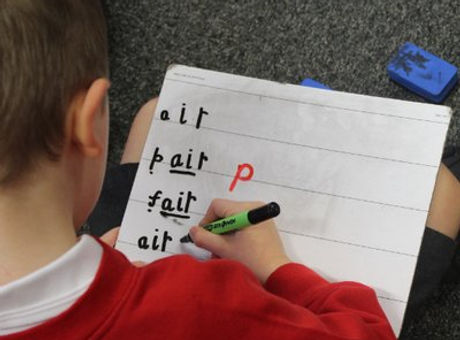Introducing Unlocking Letters and Sounds
Everything you need to teach early reading and writing.

Key Information

A DfE Validated Programme
From its careful design to reduce teacher workload, to its complete integration with the popular Reading Stars Phonics readers, ensuring absolute fidelity between teaching programme and reading books, Unlocking Letters and Sounds is the SSP programme you've been waiting for.

Progression
The progression in Unlocking Letters and Sounds largely follows the progression contained in Letters and Sounds 2007, with some refinements and clarifications of learning elements omitted from Letters and Sounds, and updated guidance, including requirements from the National Curriculum.
The progression in Unlocking Letters and Sounds is structured to follow Phases 2 to 5 of Letters and Sounds, but some phases include additional opportunities for structured revision (‘Mastery’) and for spelling development.
The detailed progression for Unlocking Letters and Sounds shows the GPCs and CEW that are taught on a week-by-week basis. You can see a summary progression, covering what is learned by the children on a term-by-term basis, here

Lesson Plans
At the heart of Unlocking Lessons and Sounds are digital lessons, one for every day of teaching, from the beginning of Reception (Phase 2) to the end of Autumn term in Year 2. Each digital lesson can be delivered on a screen or whiteboard to a class or group of children, and covers the letters/CEW introduced that day, as well as revision of work covered to date.
You’re also provided with an overview of your lessons, week by week. You can see an example overview (for Phase 2) here.
And a sample digital lesson can be viewed here.
There is also a detailed walkthrough for each Phase on how to deliver a digital lesson. You can see an example walkthrough (for Phase 2 lessons) here.

Handwriting Resources
The teaching of handwriting is built into Unlocking Letters and Sounds and letter formation is taught as part of each phonics session. So as the children learn each new letter, they learn how to write it.
In addition, regular, 5-10 minute handwriting slots should be timetabled across the week. Children need to practise handwriting under the guidance of a teacher, so that they do not develop habits which are then difficult to undo later on.
Short patters are used to support the children with letter formation, to help them visualise the letter before they write it down. These are based on the handwriting families.

Assessment
Expert assessment sits at the heart of teaching. When used well, evidence shows that it has the power to accelerate children’s learning more than any other tool available to teachers.
Ongoing formative assessment is incorporated into every lesson in Unlocking Letters and Sounds. In addition, summative assessments take place every 2 – 3 weeks, covering recent GPCs and CEW learnt, and at the end of a phase. These are 1:1 assessments that check children’s learning of taught phonemes and grapheme-phoneme correspondences, their ability to blend these phonemes and their knowledge of taught CEWs.
The class assessment spreadsheet supports teachers to quickly identify gaps in learning for individuals, groups and whole classes. From this assessment record teachers can immediately put in place intervention to fill gaps.

Supporting the lowest 20%
Unlocking Lessons and Sounds includes dedicated support for children who fall into the lowest-performing 20%. Called “Ambitious Expectations” this is a set of six focused intervention strategies that support children with reading. An Unlocking Potential Progress Sheet can be used with each child to monitor their progress.

Guided Reading
Alongside daily phonics lessons, children practise their reading skills through daily reading practise and reading lessons using fully decodable reading books.
Unlocking Letters and Sounds includes a week-by-week book matching chart and full planning for group reading sessions (for Phases 2 to 5), using the Ransom Reading Stars Phonics readers. Each session gives opportunities to teach and practice decoding, fluency and prosody, with every child having at least one guided reading session a week.
You can see a guided reading sample lesson here
ULS gives a variety of models for delivering guided reading to support the staffing structure in your school.

Printed Resources
The resources to support your phonics lessons can all be downloaded and printed from our online platform, but for schools who want to save time and ensure there is a strong Unlocking Letters and Sounds presence throughout their classroom, the following are available to buy professionally printed:
Professionally printed Sound Mats are available for Phases 2 and 3, showing the letters covered together with an illustration showing the appropriate ‘action image’ for each letter. You can see these here
(Purely downloadable sound mats are also available showing all vowel sounds and all consonant sounds - Phases 2 to 5.)
GPC Flashcards are available covering all GPCs learned in Phases 2, 3 and 5a). These are A6 in size, with A4 versions also available for Phases 2 and 3. In addition, a set of flashcards is available covering the common exception words learned in the programme. You can see some examples here
Two Wall Friezes are available, covering the letters learned in Phase 2 and Phase 3. Each letter includes the appropriate action image and is A4 in size. As the children move through each phase and learn new letters, each new letter can be added to the frieze, reflecting the children’s growing knowledge. You can view some sample letters here
Sounds Mats
Flashcards
Wall Friezes

